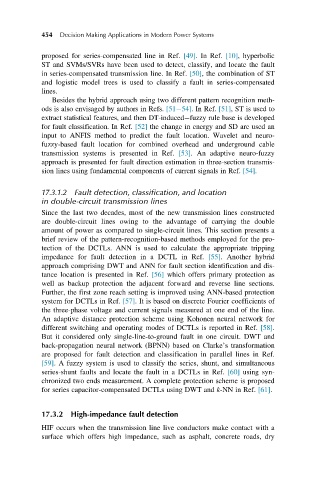Page 494 - Decision Making Applications in Modern Power Systems
P. 494
454 Decision Making Applications in Modern Power Systems
proposed for series-compensated line in Ref. [49]. In Ref. [10], hyperbolic
ST and SVMs/SVRs have been used to detect, classify, and locate the fault
in series-compensated transmission line. In Ref. [50], the combination of ST
and logistic model trees is used to classify a fault in series-compensated
lines.
Besides the hybrid approach using two different pattern recognition meth-
ods is also envisaged by authors in Refs. [51 54]. In Ref. [51], ST is used to
extract statistical features, and then DT-induced fuzzy rule base is developed
for fault classification. In Ref. [52] the change in energy and SD are used an
input to ANFIS method to predict the fault location. Wavelet and neuro-
fuzzy-based fault location for combined overhead and underground cable
transmission systems is presented in Ref. [53]. An adaptive neuro-fuzzy
approach is presented for fault direction estimation in three-section transmis-
sion lines using fundamental components of current signals in Ref. [54].
17.3.1.2 Fault detection, classification, and location
in double-circuit transmission lines
Since the last two decades, most of the new transmission lines constructed
are double-circuit lines owing to the advantage of carrying the double
amount of power as compared to single-circuit lines. This section presents a
brief review of the pattern-recognition-based methods employed for the pro-
tection of the DCTLs. ANN is used to calculate the appropriate tripping
impedance for fault detection in a DCTL in Ref. [55]. Another hybrid
approach comprising DWT and ANN for fault section identification and dis-
tance location is presented in Ref. [56] which offers primary protection as
well as backup protection the adjacent forward and reverse line sections.
Further, the first zone reach setting is improved using ANN-based protection
system for DCTLs in Ref. [57]. It is based on discrete Fourier coefficients of
the three-phase voltage and current signals measured at one end of the line.
An adaptive distance protection scheme using Kohonen neural network for
different switching and operating modes of DCTLs is reported in Ref. [58].
But it considered only single-line-to-ground fault in one circuit. DWT and
back-propagation neural network (BPNN) based on Clarke’s transformation
are proposed for fault detection and classification in parallel lines in Ref.
[59]. A fuzzy system is used to classify the series, shunt, and simultaneous
series-shunt faults and locate the fault in a DCTLs in Ref. [60] using syn-
chronized two ends measurement. A complete protection scheme is proposed
for series capacitor-compensated DCTLs using DWT and k-NN in Ref. [61].
17.3.2 High-impedance fault detection
HIF occurs when the transmission line live conductors make contact with a
surface which offers high impedance, such as asphalt, concrete roads, dry

